Construction of the Body/ Inventing Normality
1/66
There's no tags or description
Looks like no tags are added yet.
Name | Mastery | Learn | Test | Matching | Spaced |
|---|
No study sessions yet.
67 Terms
Construction Body
How understandings body socially & culturally constructed & the consequences.
Power & Agency
How was power created & applied + challenged by recipients.
🔗 rec. medicine removes our power in return for assistance
Creating Knowledge
How were ideas ab. normalcy, disease & body created + what were the consequences?
cultural impact of myths about the normal body
- The Concept of ‘Normality’ in the History of Medicine à historiography: What is the history of medicine?
- ‘Medical Historians and the History of Medicine’ à historiography: What is the history of medicine?
Conceptual problem ‘normal’ & ‘pathological’ in history medicine
How might we think ab. difference between normal & pathological?
What does 'normal' mean in history medicine?
Is it the opposite of 'pathological', or of 'abnormal'?
Is 'abnormality' the same as 'anomaly'?
Can consider Georges Cangullhem’s conceptual history normality in biology & medicine/ philosophy life as tool for exploring this problem.
Canguilhem’s philosophy of life
How does meaning normal change?
Depends on how we define it biologically, socially or existentially. Words we use change depending on context.
Canguilhem’s philosophy of life
What are 2 meanings ‘normal’? (biologically)
Statistical average (descriptive, based on observed frequencies).
Value judgment (normative, based on how things 'should' be).
How these meanings relate depends on historically specific philosophies of life.
These determine whether deviation is considered deviance.
Canguilhem’s theory of norms
What is his philosophy of life?
Understands normality & pathology in terms organism’s rel. to its environm.
Life = constant struggle to avoid harm & preserve itself (‘an organisation of forces & a hierarchy of functions whose stability is necessarily precarious’…).
This struggle propels constant return to norms (those states which sustain life).
How does Canguilhem define ‘normal’?
Sustains organism its rel. to its environm.
→ nothing intrinsically normal/ pathological.
(Canguilhem) What is the role of anomalies in life?
Express altern. forms life which can be beneficial/ detrimental.
Failures but attempts/adventures in life’s adaptation.
Way life constantly adapts to changing conditions.
Medicine & soc. often label divergence ← norms as 'bad', but life itself establishes new norms to sustain itself.
(Canguilhem) How should we evaluate anomalies?
Their value is determined by comparison w/pre-established type but by their succ. in sustaining life.
Good/ bad (pathological) depending on effect they have on sustaining/ harming life (stability, fecundity, variability of life).
If anomaly more succ. than current norm, it est. new norm (if they prove equivalent/ superior, they → normal)
If new norms inferior, they are called pathological.
What is disease according to Canguilhem?
A state where organism is regulated by norms preventing it ← adapting successfully to its environment.
What questions does Canguilhem raise ab. what normality is & how it changes?
What diff. meanings can ‘normality’ have?
biological, social, existential
What is the rel. bet. the normal as a statistical average & the normal as an ideal-type and value judgement?
History normal is shaped by that of measurement, e.g. rise statistics C19.
What questions does Canguilhem raise ab. what normality is & how it changes?
When does the normal → normative, i.e. when does it prescribe what life ‘should’ be? (statistical norm → social/ moral norm)
e.g. when doctors base treatment on individual’s felt expert. & on social consensus ab. normality
social consensus ab. what normal person senses shapes how doctors treat people who sense differently/ how soc. treats disabled people gen
What role does medicine play in determining normal e.g. by deciding conditions under which an average is determined.
e.g. Francis Galton’s ‘visual statistics’ pre-determined the group that would be averaged by his photographic composites
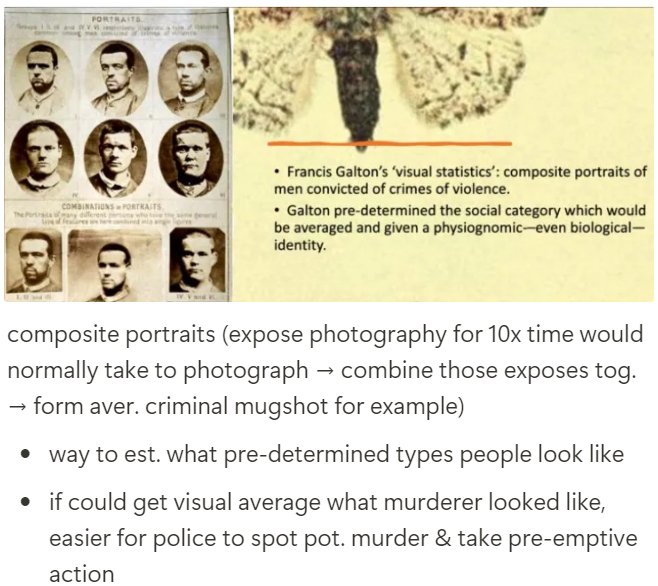
What questions does Canguilhem raise ab. what normality is & how it changes?
What is the rel. bet. ‘biology’ and social & cultural context in determining norms?
Canguilheim’s theory norms both a universalist one rooted in biology (underlying principles of life, vitalism) & a partic. 1 based on historical context.
Explain how definitional problem/ these big questions relate to unit themes body, power & knowl.
Examining changing understandings of the ‘normal’ help us to think about how:
construction body
Body has been constructed, regulated & intervened upon/ influenced through environments & medical technologies.
Statistical & social understandings normal body determine treatm. (condition doctors try to return their patients to)
Medicine perpetuates this construction ‘normal’ body through its practices/treatment of patients.
E.g. contemp. psychiatry's relies on drugs to 'correct' perceived chemical
balances(idea normal chem. balance)
These understandings normal body also shape public health (expert understandings healthy environm.
E.g. (1900s) GB prmoted 'open-air' schools to improve kids’ health in crowded,
sanitarycities.
Examining changing understandings of the ‘normal’ help us to think about how:
Social inequalities based upon psychological or physical differences have been reproduced/ contested (power).
Normative understandings body perpetuate social equalities.
(early C20 GB) Belief visually impaired person's other senses
couldfully compensate for their lack visionproduced binary ability &ability.blind person can conceive most world like sighted person, but not all of them - can’t sense world fully in way sighted person could
Know. this, activists contested medicine's hegemonic understand. body:
(1960s) Visually impaired people…
rejected 'medical model’
ability, (understoodabilityas aris. ← impairment)pushed 'social model' (claimed soc.,
person's body,disabling→abilitycontingent,inherent)
(Simeone Koole) Examining changing understandings of the ‘normal’ help us to think about how:
Social groups have claimed epistemic authority/ agitated for greater inclusion (knowl.)
History normal = that of the professionalisation & institutionalis. knowl.
Experts claim auth. → resistance activist groups in how ‘auth’. can determine normal.
Formation new disciplines (e.g. sexology & experimental psychology late C19) gave 'experts' control over criteria under which normality judged.
heightens contests over knowl. within these disciplines
increases importance claim. legitimacy knowl. outside these disciplines.
E.g. Diagnostic & Statistical Manual Mental Orders (DSM) (published by American Psychiatric Association) classifies mental orders, determ. criteria order judged by.
(1952-73) Classified homosexuality as mental
orderuntil gay rights activist protested against this classification ‘60s.Like
abilityactivists, queer activists contest. auth. medical experts to determine what’s normative/ pathological sexual behaviour.
(til 2013) DSM contin. to categorise individuals 'distressed' by their sexual orientation as mentally
ordered.
Historiography history medicine
What does Mark Jackson emphasise in history medicine?
📚 Mark Jackson, ' Introduction', in Mark Jackson (ed.), The Oxford Handbook of the History of Medicine (2011; online edn, Oxford Academic, 18 Sept. 2012).
Expands & challenges trad. boundaries medical history
Geographically
Uses GH lens → counter dominance W-focus – other areas poorly covered in historiography
Combine w/local history lens → history medicine should not be written ← W perspective (concerned only w/W-recognised diseases, cultural preoccupations, professional practices & institutions) but should indigenous medical traditions as shaped by range social & cultural factors, on their own terms.
Chronologically
Conceptually
Emphasises how medicine interacts w/social or cultural theories/ priorities
Science product culture - not objective (think phrenology → gender/ racial norms)
Methodologically
Historiography history medicine
How has writing medical history changed over time?
Whig history focus on discoverers
→ SH focus
Post-WWII context competing political views medicine & social welfare → incorporated methods & approaches SH & CH
(Dorothy Porter) Public health movement: SSHM founded to educate health professionals as alternative to overtly technical approaches to health & disease (‘social medicine’)
Shaped by James Lorimer Halliday’s psychosocial medicine & John Ryle’s ‘social pathology’…
Emphas. role socioecon. factors in disease causation & prevention (R19).
Thomas McKeown’s inaugural address refl. prof. (though marginal) medical commitm. to explor. & understand. ‘rel. of medicine to soc.’ to improve preventative & curative health care (draw lessons ← past & apply to present problems – tool enquiry → policy change)
(1970s) SSHM’s interest as disciplinary interest membership diversified
SH medicine regarded ‘an indep. scholarly pursuit, w/its own methodologies & parameters’ & divorced ← its earlier ‘vocational orientation tow. policy & administration’
Merely draw simple lessons ← past & apply them to present problemsBUT attended to social, political & cultural contexts in which medical knowl. & clinical practice formulated & patterns health & disease experiences (R23).
→ CH focus
effect medicine on cultures/ societies & vice-versa)
(1970s & 80s) Social construction → methodological framework for SH medicine: SSHM increasingly focused on social, political & cultural contextual determinants medical knowl. & practice and exper. health.
(Ludmilla Jordanova, member SSHM executive committee → shap. discipline) ‘By stressing the ways in which scientific & medical ideas & practices are shaped in a given contest’
Historiography history medicine
Challenges in writing & researching MH
1. Still divided by methods & sources + purpose medical history & nature it’s rel. w/history & medicine (picture)
2. Interdisciplinary status/ dual heritage → identity crisis/ ambiguity ab. nature & purpose )prof. uncertainty & distinct boundaries engendered hostility bet. historians & doctors ab. MH’s nature & purpose)
3. Issue relevance to modern studies: policy-relevant, not policy-led history
(Jackson) MH relevant to SH + informs current policy disputes ab./ dilemmas in health & medicine
MH articulates bet. past & present + reveals/ exemplifies how past continues to impact the past: (William Faulkner) the ‘past is never dead. It’s not even past.’
Driven by…
discipline’s historical roots in social medicine
fact public engagement & impact increasingly regarded as pivotal aspirations for academic historians & principal criterion for contin. funding (e.g. Wellcome Trust promotes focus on the applicability/relevance of historical and humanities research).
Does this by…
Offering analytical framework for eval. current knowl. claims by exploring determinants medical knowl. & practice across time & space
Raising critical questions about social, biological, political, economic & cultural factors in health & disease and hegemonic approaches to diagnosis & treatment, in order to explain changes/ consistency in clinical practices over time and prominence spec. health & disease formulations @ partic. historical moments
(Virginia Berridge, Philip Strong) Historians can locate policy change in past practice, seek out antecedents & tendencies feed. into present policy developments
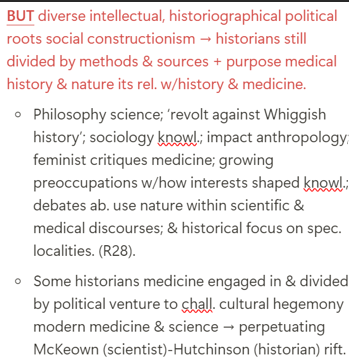
Does the normal body exist? (Sarah Jones)
When did idea normality emerge?
- Timeless idea.
- Concept ‘the normal’ as we know it today dates ß mid-C20
Does the normal body exist? (Sarah Jones)
Og meaning C19
Dry, statistical term used to discuss right angles
→ Bell curve develops as new way think ab. statistical averages (see slide)
Does the normal body exist? (Sarah Jones)
Role Adolphe Jacques Quetelet
Applies statistical tools to people for 1st time - amongst 1st to try & find ‘aver.’ human being.
Studies height, weight, strength, births, deaths, crime, etc etc.
On Man and the Development of His Faculties, or an Essay on Social Physics (1835): Tried to work out mean aver. in terms body fat distrib. (created ketelect index, renamed BMI)
Key concept: ‘Aver. Man’
New: considered normal
just as statistically likelybut as desirable.Perfect average everyone ← truest statistical representation humanity
Existed only in theory BUT represented perfect man made by God, free ← error.
“Everything differing from the Average Man’s proportions and condition, would constitute deformity and disease…If an individual at any given epoch of society possessed all the qualities of the Average Man he would represent all that is great, good, or beautiful.”
Does the normal body exist? (Sarah Jones)
Quetelet’s influence: treatment individuals (behaviour) against scale normality
Facilitated cures tried to return patients to ‘normal’ state…
Case-study ‘moral treatment’ & the asylum:
- Increasingly pop. ‘moral treatment’ aimed to treat patients like normal people & have them live normal lives so could re-enter soc., restrained physically.
- Gendered idea normality had patients do gender-approp. jobs: women clean, sew, laundry; men farmwork
- To be normal & do what everyone else did = marker good, acceptable behaviour = to be cured
Does the normal body exist? (Sarah Jones)
Quetelet’s influence: methodology
- His privileging certain groups (e.g. heavily measurements white people, left out children ← average age pushing age up) facilitated idea normal: measure average -< way to judge & exclude communities/ cultures)
- Fed into attitudes MH (hysteria)…
Does the normal body exist? (Sarah Jones)
Case-study impact field mental health: hysteria
- Seen as women’s disease – diagnosing women w/it = powerful tool social control
- ‘Catch all’ disease w/diffuse symptoms (find scholar)
- Used to diagnose those partic. in socially unacceptable/ taboo behaviours: if failed to maintain normal state… repres. behaviours seen as socially unacceptable
- e.g. for going to church more than other women, asking for divorce, hav. too high or low sex drive, not wanting to wear hat, fighting back against domestic abuse, reading too many books, Edith Manchester respectable MC women intended to live in free union (committed, unmarried partnership w/WC rail clerk) → diagnosed by physician who’d never met her - she’d wanted to commit social suicide so must have been hysteria (though got what she wanted in end)
Does the normal body exist? (Sarah Jones)
Case study eugenics: context
Normality separable ← developm. eugenics.
Exacerbated by poor health generated by urbanisation/ industrialisation & revealed in failure Boer War
Movem. great swathes people ← rural areas to urban areas; WC people in ever-_er liv. spaces
Recruit. soldiers - military had to drop height requirement 5 ft 8 → 5 ft 3; not en. men in 1st category. Under ½ men admitted met health standards.
Suffered embarrassingly huge losses
Declining health pop. fuelled moral panic…
Does the normal body exist? (Sarah Jones)
Case study eugenics: define
C19th fears (social) ‘degeneration’ (nat. body): pervasive idea white European civilisation under threat
Anxieties concerning fitness & efficiency white male bodies: people → smaller, sickly, weaker, less robust
Link to evol.: just as human race had evolved to à more complex, could slide back into ignorance, weakn. & decline.
Esp. concerned ab. WC men
Does the normal body exist? (Sarah Jones)
Case study eugenics: Francis Galton + subjectivity normality
Pioneers study eugenics/ ‘good breeding’ as way to stop decline humanity (white Europeans)
Best way = through scientific approach to race à improve health & vigour popul.
Interested in policing who could/ couldn’t reproduce to stop degeneration… framed by problematic assumptions what constituted fit/ normal… (white, abled MC).
Framed/ justified by studies ‘normal’ person
(📚 Hereditary Genus) Data gathering & statistics (e.g. composite photos criminals): law of deviation into discussions normality → ‘pedigree men’
science says this is normal, this is what we can do to achieve it
Proposed arranged marriages to achieve this
Normality like them
He never gathered data for women, just men & then altered it (white men the norm against which everyth. else was compared) → white men → healthy man; new benchmark against which everyth. judged
If you were not strong/ vigorous, seen as statistical/ medical failure (not due to circumstance but innate biological inferiority or moral weakn.)
Does the normal body exist? (Sarah Jones)
Case study eugenics: pop. eugenics
Encouraged ‘normal’ people to have babies to contin. race through prizes
Better Babies competitions - awards for best babies
v/pop. - propaganda for eugenics movem.
promote idea best babies were product good breeding
non-whites banned ← entering
GB never issued marriage licenses but some US states & European countries did, barring abnormals ← marriage & reprod.
Picture = chart ← family fair in Kansas
lots ideas normal bakedinto idea eugenics
even sterilisation… not confined to C19 (Holocaust + eugenics wards North America forcibly sterilised black women into 1970s for low IQ & physical fitness → unable to work)
normalisation popul. through eugenics effective rhetoric
oppressed minority groups
Does the normal body exist? (Sarah Jones)
How normal develops in C20
Peter Cryle & Elizabeth Stephens
(early C20) Lang. ‘normal’ bleeds out of scientific circles → mainstream culture,now well-known in pop. discourse.
(medical & scientific texts on sex) Tether idea normativity ← ideas statistical aver./ same → prescriptive ideal
How regular people thought ab. themselves & others
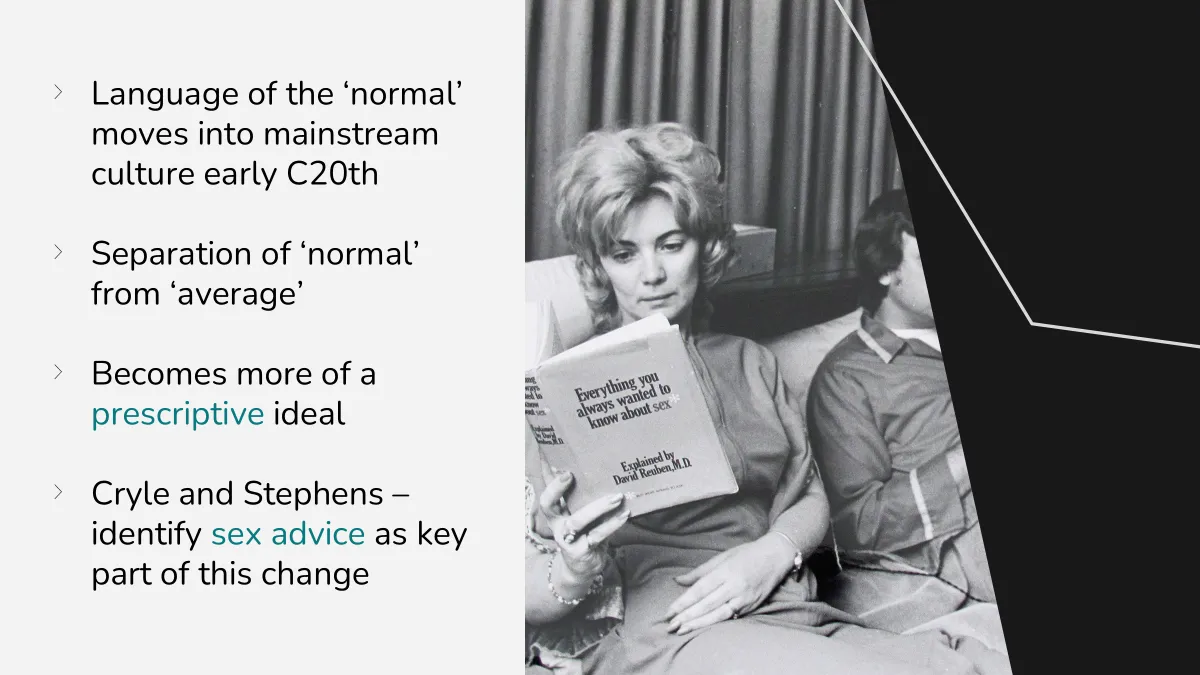
Does the normal body exist? (Sarah Jones)
How is this due to sexuality?
Peter Cryle & Elizabeth Stephens identify sex advice as key part this change… in discussions sex, lang. normal → culturally pervasive
How do sex manuals reflect this? +
how accessible
how do they reflect gendered ideas normality?
Know how received BUT bought & read in huge numbers
Ranged ← cheap pamphlets → expensive & explicit tomes worth hundreds $s
So read by wide sprectrum across soc. - pervasive genre accessed by everyone?
Prov. info to defend ‘normal’ sex
Focus on how to get sex ‘right’: promised access to good, scientific sex
Detail anatomy, explain. basics bodily processes (erections, orgasms)
Used this to inform what it said ab. nat./ normal behaviour…
By maintain. gender roles, good sex 👓n as crucial for succ. ⚭, overall health, & social stability.
How do sex manuals show how normality informed by broader power dynamics?
interwar vs PW
Angus McLaren
Through focus on enhanc. ♀ pleasure & mutual orgasm, emphas. ♂ respons. for sexual technique (emphasis on restraint, patient & timing - nice guys finish last)…
defines ‘normal’ men & women as hav. clearly defined sexual roles
👨 = active, dom. (swift, ready, active → alw. ready to perform)
👰♀ = passive, submissive; helplessn. req. male intervention
👨 initiators sexual pleasure, responsible for awaken. their 👰♀' sexuality. ♀ orgasm was central to a succ. ⚭
C. B. S. Evans’ Man & Woman in Marriage (1931). Women’s fundamental sensitive femininity req. consid. attent. their husbands.
Rev. Henry Tyrer’s Sex Satisfaction & Happy Marriage (1940): ‘More psychological damage may be done the 1st night, or during the honeymoon, than the balance of life will be able to correct’ (woman’s 1st sexual exper. could scar her emotionally & irrevocably if husband failed to
(Marie Stopes) Sex had to be ‘mutual affair, not the mere indulgence of a man.’
(though did indicate central concern for women’s pleasure) - contradiciton in assertion 👩 had own sexual needs but
could fully express them autonomously
celebrated potent male heterosexuality
Marie Stopes: asserted in UC & prof. classses, 1/3 wives had non-virile husbands
Margaret Sanger chall. her male readers to prove by their passionate lovemaking that they hadn’t fallen victim to effeminisation
Concept mutual orgasm initially important but later diminished in favor of ♂-centric views of sexuality…
their sort should not reproduce - see earlier thing on eugenics (homosexuals, fetishist s & habitual masturbators should not wed; sexually anesthetic or neurotic women advised to remain celeibate… - check bottom Notion page
How do sex manuals show how normality informed by broader power dynamics?
interwar vs PW
(Sarah Jones) Concept mutual simult. orgasm
New emphasis both partners should have simult. orgasms
(Van de Velde, 📚 Ideal Marriage: Its physiology & technique: 1932) ‘In normal & perfect coitus, mutual orgasm must be simult.’
Normal & perfect used simul. =
Prov. handy chart → see what looks like real life
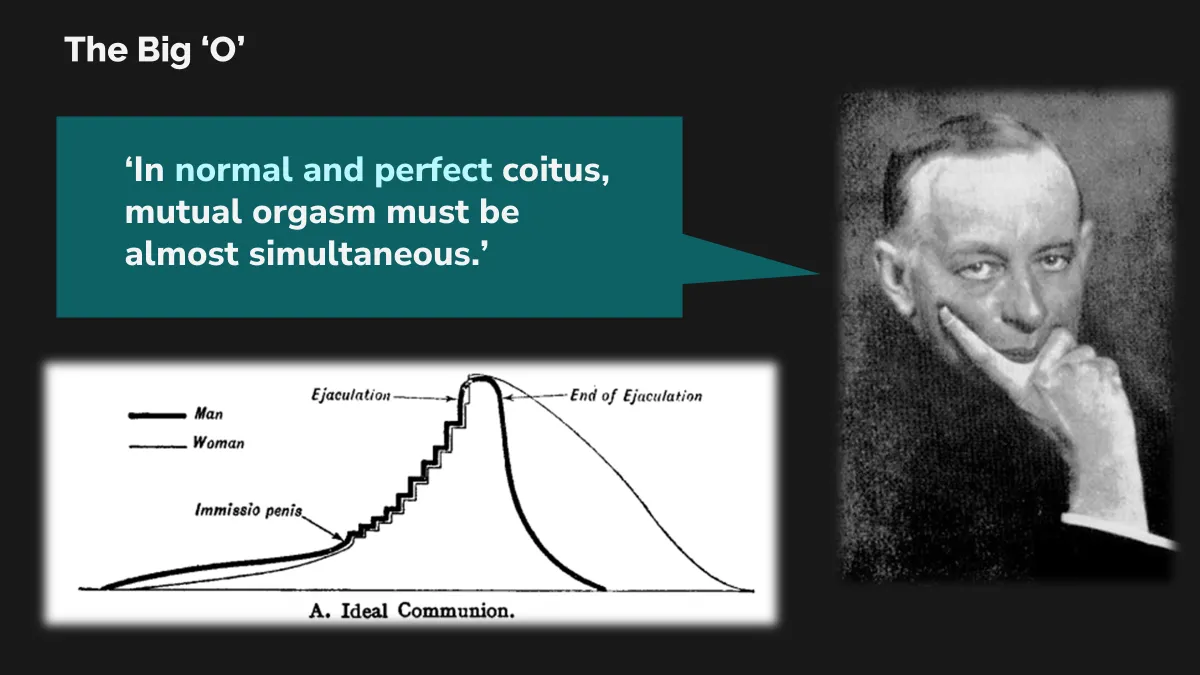
How do sex manuals show how normality informed by broader power dynamics?
interwar vs PW discourse
Angus McLaren
Concept mutual orgasm initially important but later diminished in favor of ♂-centric views sexuality…
(Elaine Tyler May) Influenced by Freudian theory sexual developm. & ‘vaginal orgasm’, redefined ‘normal’ ♀ as orgasmic & sexually functional
👩 → intended aud. for instruction & response. for own climax, 🤵’s
fidelity& keep. her genitals odour-free.Decline in import. clitoral stimulation
Locus sexual sensitivity ← ♀ to ♂
👨 ↑ fragile & sexually vuln. (sexuality subject to
function&extricablyentangled w/his sense self-worth) - emasculat.Eustace Chesser’s Love W/o Fear: How to Achieve Sex Happin. in Marriage (1947): women who couldn’t attain orgasm should learn how to simulate climax (R48).

What does this raise questions of?
Why have some groups been so invested in telling people what kind sex they should have?
So what is normal ‘sex’? What does it reveal ab. those who instill it?
Tool social control?
Way to reinforce ideas ab. approp. sexuality in conext upheaval & anxiety
Someth. that held up/ fortified hierarchies around class, race, gender & sexuality
Progressive?
Agent control, way dictating hierarchies & policing behaviour?
Serve to reinforce restrictive boundaries ab. what constitued desirbale/ acceptable expression
Vision normality
statisticalbut on ideals alw. at risk
How does sex demonstrate this?
Heightened concern w/female sexual responsibility & poss. failure male potency revealed norms these manuals helped contruct & how social change had undercut those norms
(Elaine Tyler May) PW, viewed ♀ sexuality as danger. force need. ‘containm.,’ sim. to ☢ power.
Jessamyn Neuhaus (The Importance of Being Orgasmic: Sexuality, Gender, and Marital Sex Manuals in the United States, 1920-1963) Cultural & societal context
Focus male sensitivity revealed great anxiety &
certaintyab. those norms, partic. ab. strength & vitality US manhood (illustrat. their fears nat. vuln.).
Reflected CW anxiety ab. male ‘softn.’
CW commentators used "softn." to express fears ab. nat. vuln. (e.g., "soft on communism/ homosexuality)
Powerful erections symbolised 💪 front against peril perversion fac. US → curbing marital ♂ sexual
functionreq. all advice & reassurance experts could provide.
→ Experts prov. extensive advice to curb ♂ sexual
function& maintain nat. 💪.
Way maintain ⚭ as response to chang. sexual norms, meet. demands w/o fundamentally chall. ♂ power.
Contradictions in interwar manuals reflect soc. grappling w/’the woman question’
Women had sexual needs must be met for marriage to succ. BUT wives depended upon their husbands to ‘awaken’ those needs.
Women = fragile creatures who req. tendern. & delicacy on husband’s part (partic. dur. honeymoon) BUT orgasmic sexual pleasure critical to woman’s good health.
Masculine sexual power absol. essential BUT husbands bulbimbling, ignorant, sensitive clods who needed instruction on pleasuring wives.
(1947) Ferdinand Lundberg & Marynia Farnham asserted ‘modern woman’ experienced
satisfactionin her sex life mostly because she refused to submit fully to her role as wife & mother.
What does this reveal about normality?
→ attempts to pin down ‘normal’ coloured by subjectivieis, inherently viewed w/social meaning
connected to positions power & attempts to shore up diff. hierarchies
powerful tool social manip. & political power - pushes out anyth. not normal & pushes certain vision of what should be done
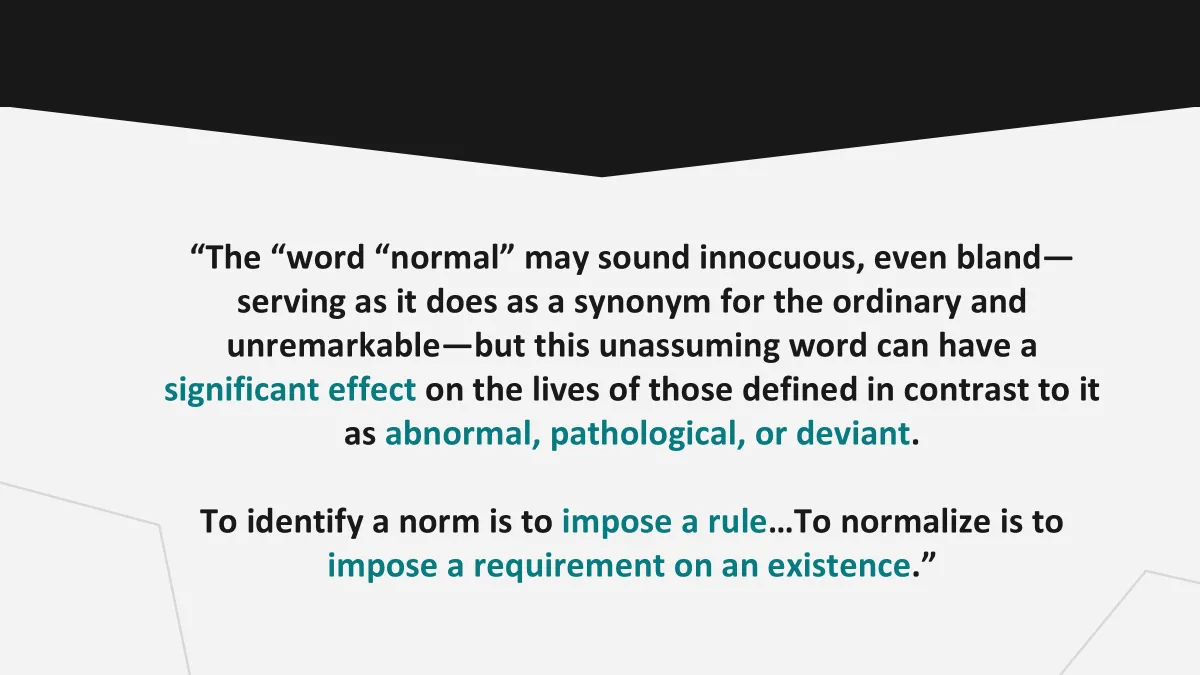
How does sexology fit into attempts to categorise normality?
(Sarah Jones) Explicit attempt to measure, define and categorise 1 most important parts proc. to bring concept sexuality into being
Dedicated to scientific study diff. aspects human sexuality
Richard Von Krafft-Ebing (1840-1902)
how did he reflect common interest sexologists
normality same-sex desire & sex
Sexologists took as their subjects all diff. types sexual behaviour → sort it into types: interested in perversions.
📚 Psycopathia Sexualis (1886) = 1 principal works sexology
Intended as forensic handbook for lawyers & judges involved w/legal regulation sexual crimes
Interested in defin. & categoris. so-called ‘perversions’
Covers range ‘pathological’ (normal) sexual behaviours (reproduct. sex)
Anyth. fell out this v/strict binary bad… symptom disease
Coins key terms like ‘sadism’ & ‘masochism’ + discusses ‘homosexuality’, ‘bisexuality’ & ‘heterosexuality’
Found trends & commonalities → sort people into these diff. categories/ types: should be thought of as homosexual/ heterosexual
1st to talk ab. homosexuality etc as distinct sexual identity - created labels we used today
Writes ab. them in judgemental way
Havelock Ellis (1859-1930)
what normal/ nat. sexual natures men & women should be (sexual difference)
Sexologists just interested in defin. & categoris. so-called ‘perversions’…, but also in mark. out what is normal/ nat. against which those perversions could be defined & read
📚 Man & Woman
Used in-depth studies individuals to come to conclusions ab. everyone’s sexual natures… whole nature of the sexes as a system
Normal for men to have more active sex drive (sim. to sex advice we’ll see later) vs women (nat. passive… if possessed too strong sex drive, perverse/ sick ) - quote
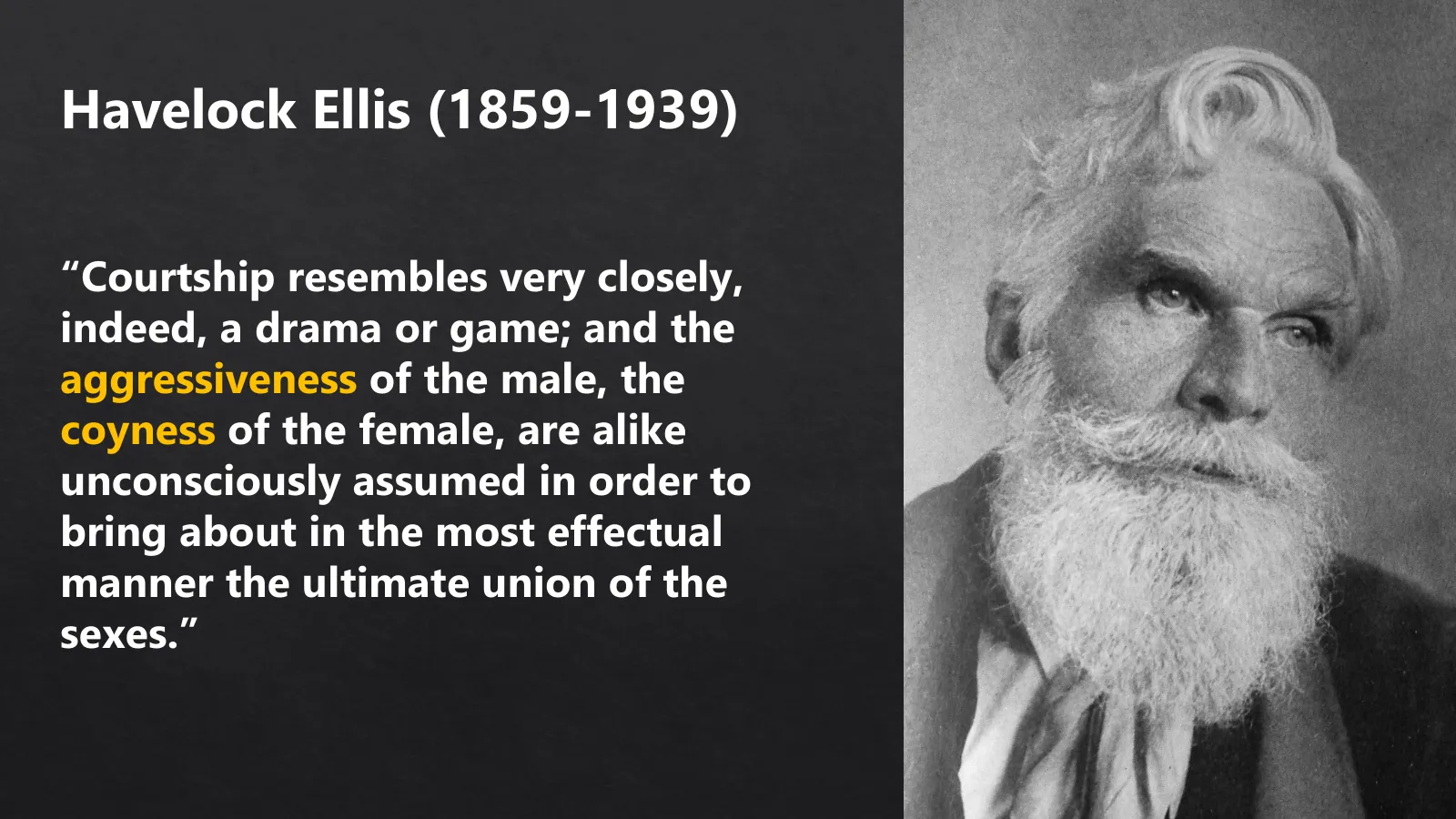
This proc./ understanding sexuality that’s been prod. has been understood & treated in v/diff. ways…
Sexologists have been celeb. as progressive forces/ figures…
Krafft-Ebbing’s view should pity homosexuals (harshly criminalise them)
Magnus held up as celebratory figure - still remembered as pioneering advocate gay & trans people
Studying sex seen as form activism in its own right, giv. peole framework to make sense of their desires & prov. vocab to articulate themselves to others.
= optimistic way seeing sexologists as laboratory, kind & benevolent figures who created ways for people to understand themselves/ found ways for people to discuss their desires & fit into world more widely
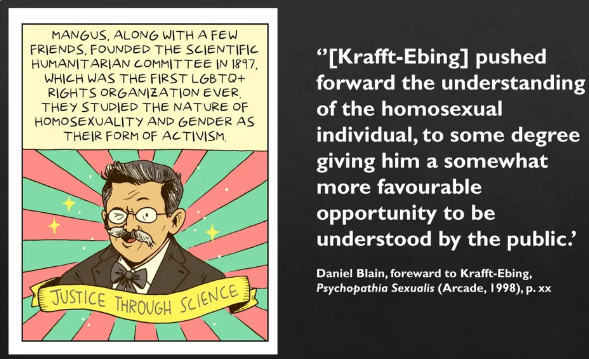
How did Foucault interpret impact sexology?
e.g. homosexuality
Through this proc. produc. knowl. ab. sex, sexual science created ‘sexual subject’ (Foucault).
E.g.) Rather than seeing same-sex sex as 1-off aberration, by…
Constructing & naming category homosexual & then fitting people into it…
Diagnosing them against this criteria they created
Encouraging people to think of themselves in that way as somehow diff./ sep. type to others
They create that partic. identity… identify someth. alr. there/ uncover someth. repressed as objective observers but bring it into being, make it themselves through this proc.
(Sarah Jones) In doing so, est. v/spec. medicalised ideas ab. what counts as normal vs abnormal sex.
This proc./ understanding sexuality that’s been prod. has been understood & treated in v/diff. ways…
Sexology = insidious way to regulate & control people’s lives
(Foucault) Turned clinical gaze onto sex, creating categories to show what was normal/ acceptable & what was
Pathologised sexuality, mak. anyth.
fit into their strict criteria a medical issue/ diseaseGive people opportun. to be themselves: people’s desires forced them into box, then classes as perverse to set them apart & exclude them ← nat./normal
Ruthless figures control who defined normality, whose concepts we somet. butt up against today
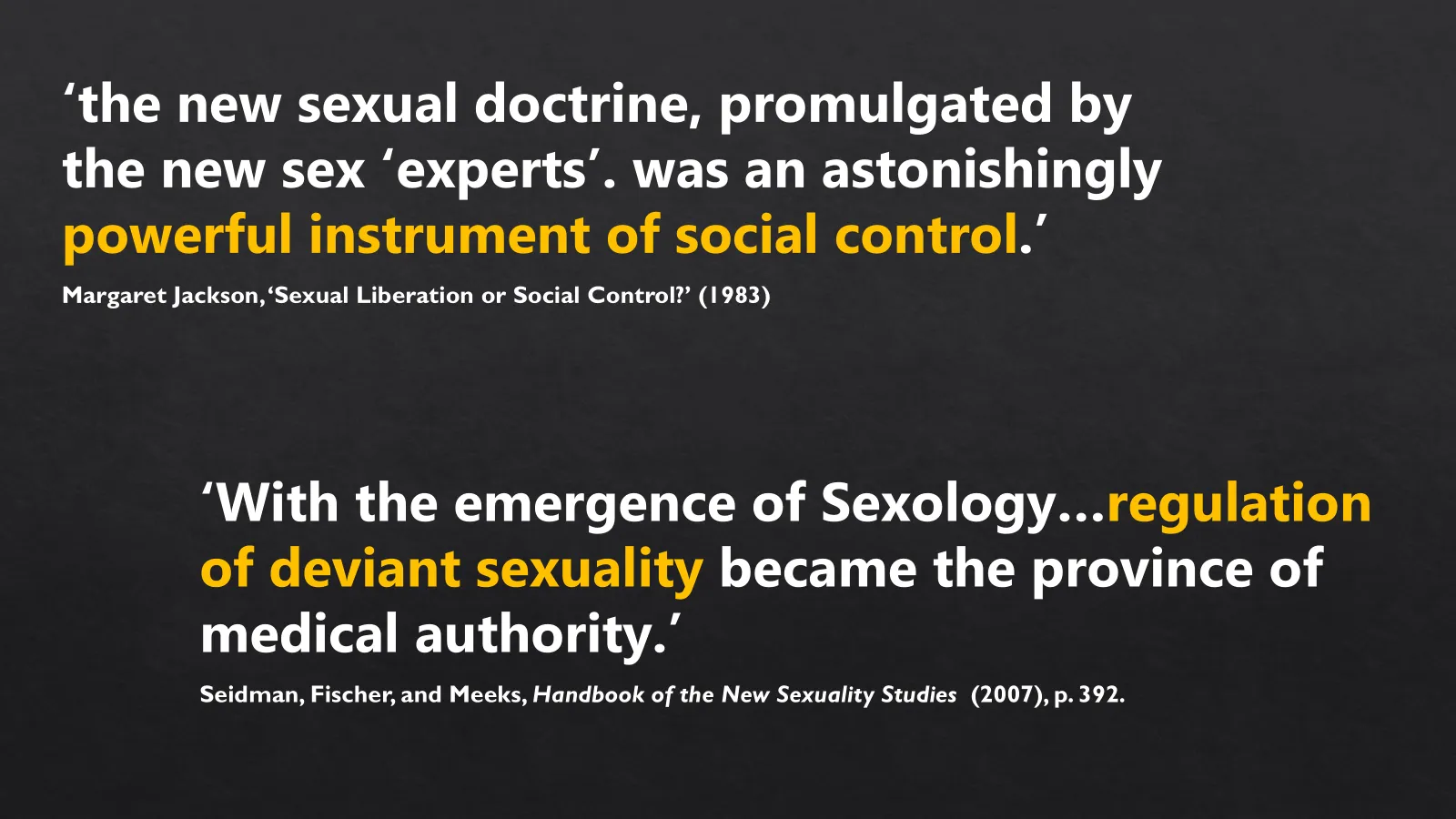
Why did sexology shift ← Europe to USA? (important)
still taboo - lots sexual science research scattered & peacemeal
founding GB Soc. for Study Sex Psychology - founding major institutions BUT major setbacks…
working in Euorpe & dying out into C20
Hershchell forced out of his work → escapes to USA in exile
midC20: field recovers & thrives but focus sexology shifted GB & Europe → USA & involves new gen. scholars doing diff. kind of research
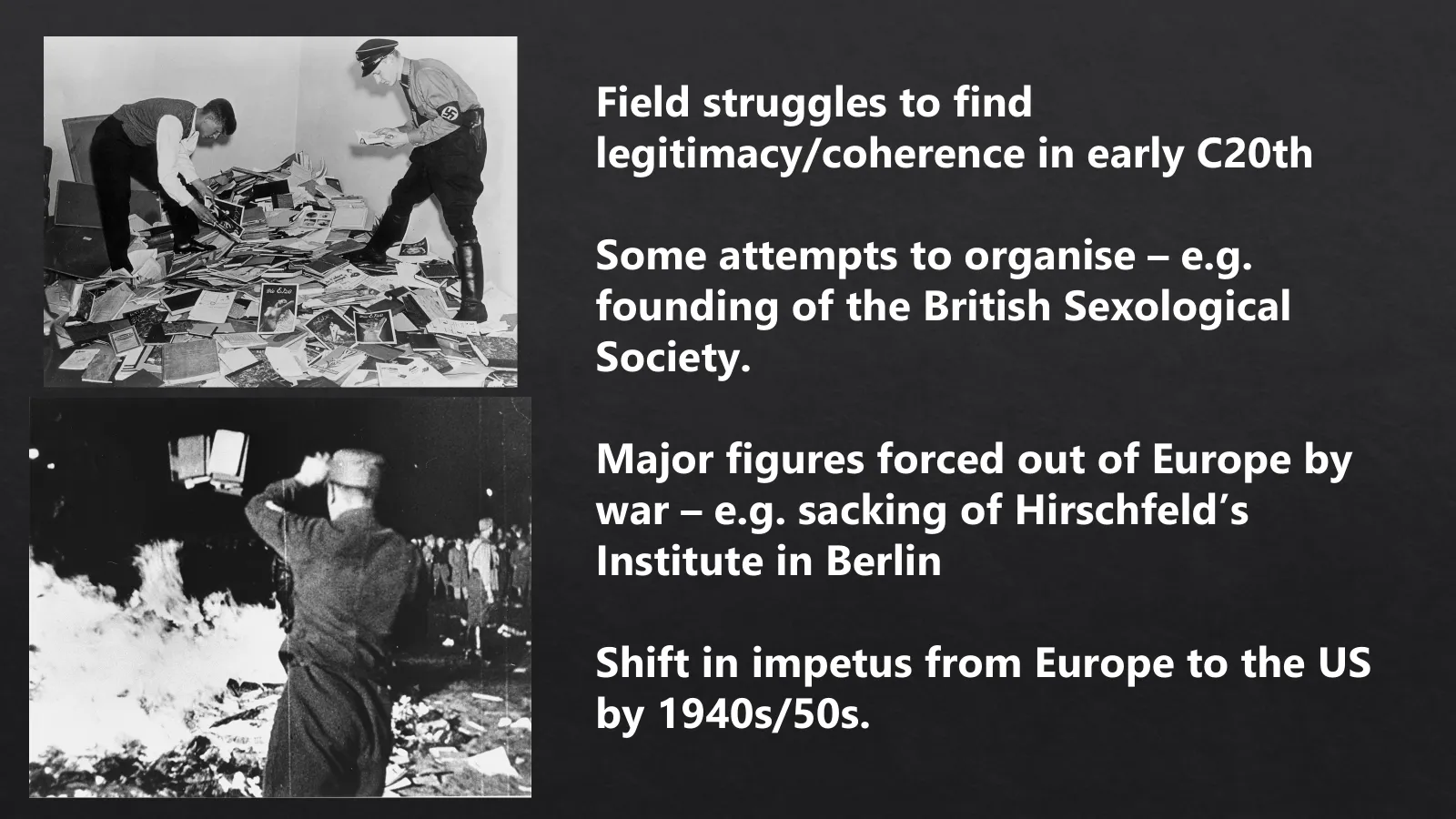
Alfred Kinsey (1894-1956)
methodology
sources
difficulties research
Believed could prod. more rigorous, scientific research by applying taxonomic methods to human sexuality.
Used in-depth interviews + collection artifacts, books & other data
Mirror. his approach on wasps, amassed
precedent.amounts data on human sexual exper.
Difficulties in research
Diverse range people ← urban & rural areas, members clergy… BUT exper. diffic. accessing certain groups (WC women & African-American communities) BUT innovative even tried to get range people, distanc. ← prev. white MC married couples characterised prev. studies
What are the 2 most important sexological works by Alfred Kinsey + what are they collectively known as?
Sexual Behavior in the Human Male (1948) + Sexual Behavior in the Human Female (1953) = the Kinsey Reports.
What did the Kinsey Reports reveal about American sexual culture?
What sexual behaviours did they highlight as hav. high rates?
Examples
Shocking revelations
Diverse sexual practices chall. prevailing ideas ab. sexual morality & assumptions sexual practices
High rates masturb., sadomasochism & homosexuality
1/10 aroused by sadomasochism
Over ¼ engaged in extramarital affair
Over 1/3 men had had homsexual experiences
Alfred Kinsey
key works
conclusions
reception
Prod. 2 most important sexological works C20: Sexual Behavior in the Human Male (1948) + Sexual Behaviour in the Human Female (1953) → tog. known as Kinsey Reports
Shocking revelations ab. American sexual culture - often clashed w/prevailing ideas sexual morality + assumptions sexual practices
High rates masturb., sadomasochism & homosexuality
1/10 aroused by sadomasochism
Over ¼ engaged in extramarital affair
Over 1/3 men had had homsexual experiences
Hugely pop., widely read, v/influential - some scholars call it k-bomb ∵ shockwave impact
What revolutionary idea about human sexuality was proposed by Kinsey?
Human sexuality should be viewed on a gradient rather than as a heterosexual/homosexual binary.
What tool did Kinsey create to represent the spectrum of sexual orientation?
Kinsey scale, which ranges ← 0 (compl. heterosexual) → 6 (compl. homosexual).
How did people respond to the Kinsey Reports regarding their own sexuality?
Kinsey received 1000s letters ← people discussing their concerns ab. their sexuality.
How did the Kinsey Reports impact societal norms and sexual discourse?
cultural shift tow. accepting diverse sexual identities & practices
showed sexual deviance more common than believed → legitim. concept sexual diversity
encouraged public discussion sexuality/ more acceptable to discuss sexuality openly
more open treatm. sex/ revision existing norms to correspond to common practices
undermined Victorian taboos/ culture conservatism
→ considered by some as ‘father sexual revolution’
Why were the Kinsey Reports controversial?
major misgivings ab. ethicacy & reliability his scientific method…
filmed staff & students hav. sex in house where did research
criticised for interviewing non-representative groups, such as pedophiles and prisoners, raising questions about the validity of his sample.
What did historian John D'Emilio say about the influence of the Kinsey Reports?
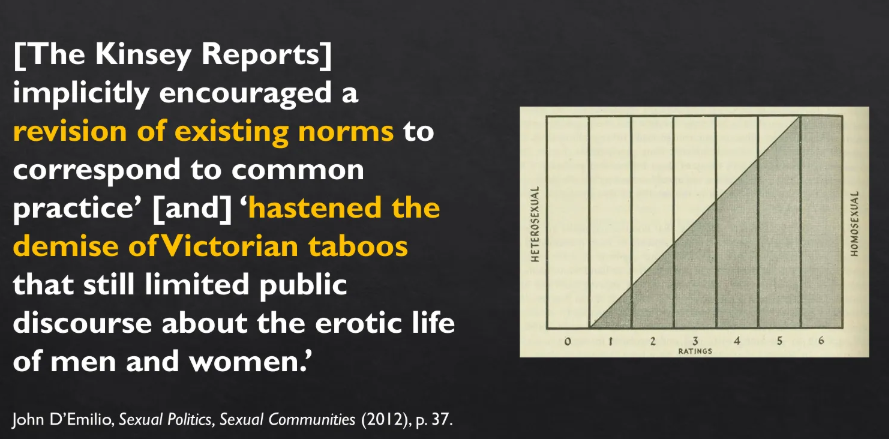
Kinsey initiated larger movement in sexology… influence k-bomb on sexology
William Masters & Virginia Johnson
research interests
what did they pioneer?
what theories did they develop
Explosion sexological work, refl. concern w/science sex
e.g. William Masters & Virginia Johnson
interests in anatomy & physiology human sexual exper.
pioneered new technologies & techniques for sex research
develop theories ‘human sexual response cycle’
William Masters & Virginia Johnson’s
key texts
methodology
political context + aims
examples new technologies & techniques they pioneered
reception
Key texts: Hyman Sexual Response (1966) + Human Sexual Inadequacy (1970)
through 1st-hand observations in their lab, undertook research into anatomy & physiology human sexual response, partic. women (context WLM)
observed over 10,000 orgasms through masturb. & sex
pioneered things like ‘penis camera’ (film inside vagina dur. woman’s masturbatory orgasm’
phenomenon: sell 100,000s copies even though technical texts - sits top NY bestseller for weeks
sexology x feminism
How did these assumptions reflect broader social, cultural, and political issues?
Why were contemporary feminists so invested in ideas about 'normal' sexuality and women's bodies?
Pop. sexologists’ reaffirm. women’s sexual dependence on men (nature female desire & lib.) ensured 2nd-wave feminists would have to take up issue women’s orgasm: issue sexual pleasure, marriage & organ. heterosexuality.
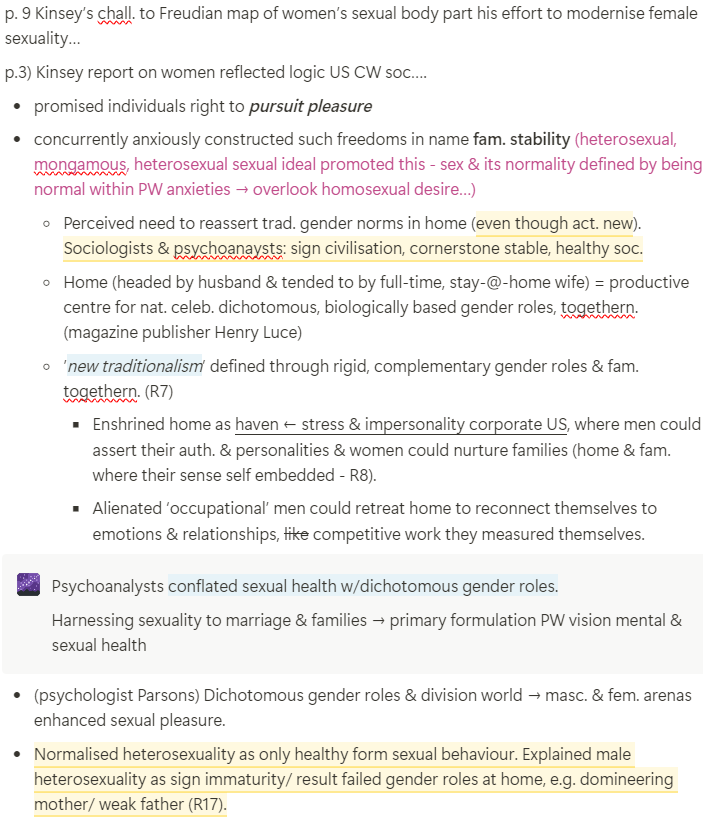
Asserted common ‘human’ sexuality based on orgasm: Kinsey tried to use ‘science’ to prove men & women sim./ identical sexually → free women to engage in pleasurable (because more accurate) sex… (p.9)
Findings → these sexologists as liberatory force
women as sexual beings → certain behaviours
part more gen. emphasis men & women’s sexual sim.
historians
FINISH THIS + REF. KINSEY
Sold themselves as radical revolutionary liberatory figures
Rallied against trad. Freudian interpretations female sexuality (vaginal orgasm en., women sexually passive/ lacked high sex drive, interested in sex…)
(Kinsey) Documented range sexual behaviour women engaged in (+ homosexual, premarital & extramarital sex)
(Masters & Johnson = rest) Chall. sex expert knowl. by using physiological data to prove super-responsiven. clit & women’s unique capacity for multiple orgasms - women more responsive for longer periods time than men - new portrait abundant female sexuality
recogn. autonomous female pleasure
Women had desire for & capacity to reach orgasm/ sexual releas → physiologically capable more orgasms + engaged in behaviours like masturb., adultery & homosexuality
Physiological diff. bet. woman’s orgasms, however they got there - undid prev. privileging vaginal sex as only right way to orgasm
Part more gen. emphasis men & women’s sexual sim.
Implicit analogy bet. penis & clit (little penis)
Clitoris only → orgasm,
lesbianism/ pathological envy men.
'These "scientific facts" affirmed women's political claims for sexual pleasure and entitlement and this feminists saw sexologists as allies in their struggle against ignorance and sexism.' Teifer (1991) in Ross Morrow, Sex Research and Sex Therapy (2013), p. 94
'This finding proved tremendously liberating for scores of women who felt inadequate, incomplete, or immature if they had been unable to experience the so-called vaginal orgasm during intercourse.' Leiblum and Pervin, 1980, in Ross Morrow, Sex Research and Sex Therapy (2013), p. 94
What assumptions were they making ab. 'normal' women's sexual response, & what sex should be like? → these sexologists as oppressive force
Janice Irvine: may have looked good on surface but even implications for women
Masters & Johnson: Phallocentric framing female sexuality
Framed female sexuality in male terms
Compared clitoris to penis, mak. male anatomy reference point/ default sexulity against which everyth. measured
Paints penetration as telos sex… which maximises male,
female, pleasure…
Masters & Johnson: Heterosexual monogamy remained assumed framework
Generated account female body (super-responsive, clitoral & pot. autonomous ) had pot. to explode construction gender in sex expert’s knowl. BUT lodged in monogamy & marriage
Reflt. assumpt. monogamous, hetrosexual marriage = norm (only addressed heterosexuality)
Upheld penetrative intercourse as pinnacle adult sexuality
Treated foreplay as secondary; acknowl. but still subordin. clitoral stim.
Encouraged women to teach men how better to arouse them sexually
Persisted/ affirmed sexual diff. (despite ‘equivalence’ claims)
Kinsey: by locating it in realm psychosexual (emphas. psychological diff. bet. male & female sexuality).. women nat. romantic
Interpreted women’s & men’s diff. levels response to visually stim. images/ ‘psychosexual stimuli’ & to love as indicative inherent &
refutablesexual diff.: women had essential & psychological orientation tow. love (found love erotic - social aspect female sexual pleasure), whilst menMen reacted more to visual stim. than women → women more sexually suggestible → more sexual than women; world for them filled w/more pot. erotic stim.
Masters & Johnson: difference bet. male & female pleasure
Study showed women’s capacity for multiple orgasms
(female pleasure) Masturbation ranked higher than intercourse
5. Missed Opportunities & Containment of Radical Potential
Radical potential of findings contained:
Framed discoveries within rigid narrative of equivalency
Sustained heteronormative frameworks
How should we evaluate 1960s sexology?
Sexology of the 1960s: Progress with Constraints
Science reaffirmed traditional dependencies:
Female dysfunction treated with male love as the cure
Women's pleasure affirmed, but framed within dependency on male partner
Radical discoveries (female autonomy) sidelined
Marriage and intercourse remained central:
Woman as "empty vessel," given meaning by what filled her
Failed to challenge heterosexual marriage as sexual ideal
4. The "Ideal Woman" of 1960s Popular Sexology (p.80)
Revision of Victorian ideals, but still constrained:
Extensively involved foreplay, clitoral & oral stimulation
Ideally orgasmed as often as male partner
Shared desire for satisfying sex — equivalent to male sexuality
Yet remained devoted to male pleasure and romantic love
Role within heterosexual dyad:
Encouraged to teach men how to arouse her better
Highest goal: simultaneous orgasm via penetration
New standard: sexually expressive, eager to please, balanced between passivity and aggression
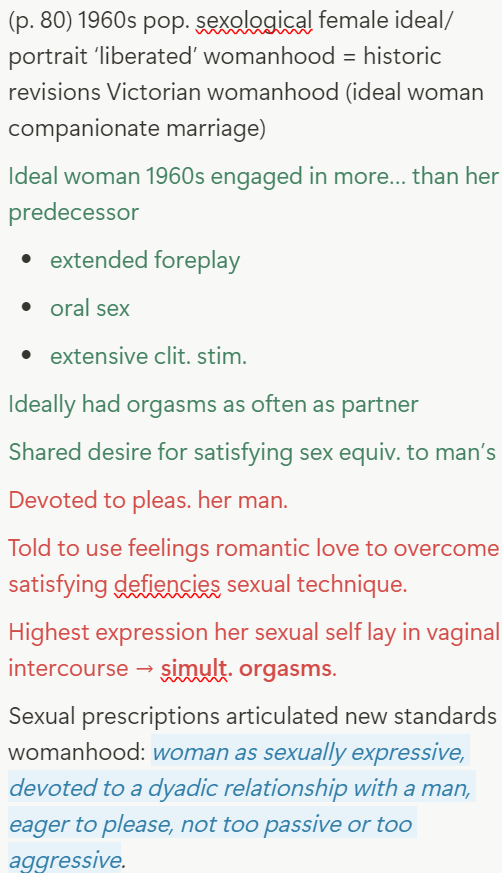
Kinsey + William Masters & Virginia Johnson impact on sexology
Kinsey pioneered use of computer tech. in sexological research
Used punched card machined to code raw data - allow. him to proc. huge amounts info
This tech. → shift ← (subjective) qualitative → (objective) quantitative methods
How were Kinsey + William Masters & Virginia Johnson part wider trend?
links to objectivity ideas normality
1960s & 70s, where sex researchers turned to ever more spec. forms of tech. tailored to fit/ designed to measure diff. aspects sexual response
(Donna Drucker) increasingly rely on broad range machines to help them w/their studies (machine-based research)
Getting more specialised? Can detect tiniest changes to body & can see inside body, giv. accurate answers.
Kinsey: science could measure w/objectivity & distance
→ sexology takes leap forwards in legitimacy, convincing to public who want impartial, morally sound discourse on sex
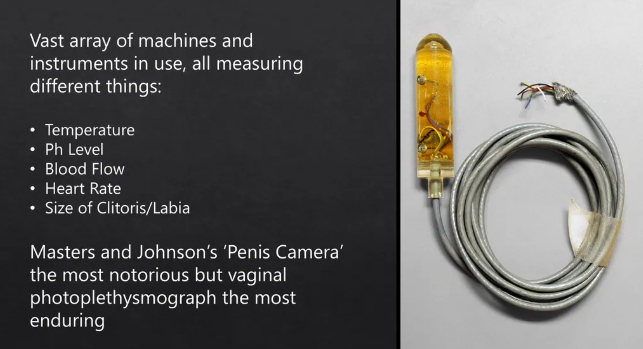
Think carefully & critically ab. kinds research they were doing & how really able they were to measure sexual normality…
Makes sexology look more prof. & legit.
Depersonalises sex research
Treats desires & behaviours like raw data, divorc. it ← indiv. & intimate reality of people’s lives.
Methodological validity
Harder to code answers to broader questions
No room to reflect what sexy story/ funny joke is
Must manip./ prune answers to fit them into system
Rigorous categorisation answers to be coded into computers leaves little room for subjectivity.
Spacefor dynamic discussions sexuality; could only answer w/answers sexolgists had alr. thought of.
(Donna Drucker) Diversity approaches → accusations
know what they were looking for & why.; what should measure & find out.Rather than hav. robust scientific method, grubbed around in dark & tried to extrapolate law ab. normal sexuality ← it
→ Rudimentary, bizarre, painful, invasive
Fig. 4.1 American research team rubber balloon inserted into uterus via cervix using a speculum, then filled w/lot of water
idea: as it swells out, they could use that balloon to measure strength of contractions on balloon as woman had orgasm
but so painful that most women couldn’t achieve sexual arousal, let alone orgasm, & had to have the balloon removed
Intention measure arousal by examining chang. temp./ PH by attaching electrodes/ thermometres to vagina, labia, rectum, breasts = pointless, just more invasive way measur. core temp.
Why was there such a discrepancy bet. scientists’ readings & volunteer exper.?
Vaginal pulse amplitude (VPA) found from light emitting thing might be seen to measure arousal but didn’t map onto actual exper… women’s records of arousal didn’t match bloodflow
Experts dec. that meant arousal, against women’s testimony being tested: Kinsey’s divorcing qualitative quantitative
How effective were these methods? Can we say they simulated ‘normal’ sexual conditions?
Hailed as revolutionary but lots holes that even non-scientifists coujld poke at their methods
All tests observed in scientific lab. - penis camera filmed in well-lit lab, in presence research team & people invited to observe (1 got so close to masturbating woman got hit with it): woman hav. wank in room full people with hood on to protect anoynmity (if they wanted to)
what kind of people were they getting? (CHECK)
embarrasment could increase heartrate
how does know. vaginal temp. help us
what assumptions normal sex shaped thier methods & what shaped those
were they studying normal sex or someth. v/diff

So were these US sexologists good or bad?
mak. norms more progressive
marshall con. ideas what’s normal
Sheila Jeffreys = classic feminist text
not progressive group but used sexology to enforce their ideas what normal sex should be like
